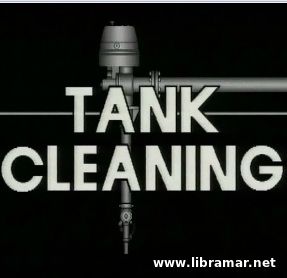Introduction to Ballast Operations (continued)

continued from here
Air Drawing
If a pump draws in air while in operation the noise is produced and the amount of sea water discharged decreases, significantly lowering the pump's operating efficiency. Also, the amount of sea water being discharged will drop to zero in an instant once a pump is drawing a large amount of air. Why? When a small amount of air is drawn into the pump, the air passes out of the pump together with the sea water.
But, if a large amount of air has entered a pump, it gathers and gradually spreads to the pump periphery, decreasing the centrifugal force the sea water receives from the impeller and disabling the pump from discharging. If the discharge amount is extremely small, there are cases where unnoticeably small amounts of air gather within the pump and build up to a level that could disable the pump. If left as it is, sea water in the pump will run out resulting in burn.
There are several ways to prevent air drawing. Purge air thoroughly before starting the pump. Decrease the suction flow from the bell mouth by reducing the discharge valve opening to decrease the discharge amount. Note, beforehand, the water level at which pump begins to draw air and stand on the alert as the water approaches the critical level. You may use other tanks with a suitable water level to continue discharging. With some ships, cargo planning is based on the hull with trim at the stern. It is the suitable condition to discharge all the remaining ballast.
Water Hammer
If flow velocity within the pipeline suddenly changes due to valve operations at the start of or during the ballast operation, the pipeline internal pressure increases momentarily and sharply. This phenomenon is called water hammering. Water hammer can damage the pump casing, valves and pipeline.
Valve Opening and Closing
In ballast operations, attention should be paid to valve opening and closing. If a valve is abruptly opened or closed, it causes a sudden change in pressure within the pipeline. As a result, the valve can be damaged. Also, the dresser joint may break due to excessive load on it. The key to avoiding such troubles is to open or close valves slowly. It is also important to reduce the amount of flow in advance so that sudden pressure impact will not be placed on the pipeline.
In addition, general points to remember to avoid water hammering are as follows: pay attention to the difference in pressures in both ends of the valve, begin ballast operation with the small capacity and at a slow speed, and fill the ballast line with sea water and confirm that the line has positive pressure.
Pressure surge takes place when the flow velocity suddenly changes inside the pipeline filled with fast flowing water due to abrupt opening or closing, whether remote or manual, of butterfly valves. In the event of a pressure surge, a high pressure phase propagates through the pipeline at a velocity faster that the speed of sound causing damage to structural parts of the pipeline. So, valves must be opened or closed slowly. With butterfly valves, since flow is not proportional to valve opening, remember that the large quantity of water may flow even if the valve opening is small. Open valves gradually by inching, stop when slightly open and observe the state of things for a while. For valve closing, also do it gradually by inching. In fact, most of the troubles associated with ballast operations can be avoided unless you open and close valves abruptly.
Simulated Ballast Operations
To carry out ballast operations, you must fully understand the ballast pump structure and its characteristics as well as your ship's ballast system. Sticking of a tank's air vents and so forth can cause the tank to expand or shrink which may damage the hull. Therefore make it a rule to conduct inspection and maintenance in your daily routine. For ships with cargo holds into which ballast water is loaded, be sure to confirm that their cargo holds are ventilated.
To begin with, set all valves at appropriate openings; while in operation, only operate the valves to be used. To avoid wrong valve operation, secure a cap on each of the valves not in use. When opening or closing valves, make sure to pay attention to the pertinent pressure gauges. Also check the pertinent level gauges from time to time. When carrying out any task, never fail to answer back, check, execute and report.
When filling ballast water by gravity, start with putting the line valves in a proper order to bypass the ballast pump. To the extent possible, conduct ballast water filling into a main empty ballast pipe. When the main pipe internal pressure is negative, inch open the pipe slightly and observe the state of things for a while, then fill ballast water slowly. After ballast filling by gravity is over, you may proceed with filling by means of ballast pump. Before starting the ballast pump, completely close the discharge valve to avoid overload at the start and to minimize surge pressure.
 Centrifugal pumps are commonly used as ballast pumps. Before starting the ballast pump, communicate closely with the engine crew to avoid any accident due to lack of communication, confirm that the power supply is switched off, purge air from pump, confirm that there is no abnormality with the pump's rotary shaft, confirm that the suction valve is open and delivery valve is fully closed. Just before starting the pump, check the procedures again following order of operation abiding by the pipeline layout diagram.
Centrifugal pumps are commonly used as ballast pumps. Before starting the ballast pump, communicate closely with the engine crew to avoid any accident due to lack of communication, confirm that the power supply is switched off, purge air from pump, confirm that there is no abnormality with the pump's rotary shaft, confirm that the suction valve is open and delivery valve is fully closed. Just before starting the pump, check the procedures again following order of operation abiding by the pipeline layout diagram.
After the ballast pump has been started, check the ballast pump electric current value, discharge pressure and suction pressure. When changing ballast tanks for filling, open the tank's suction valve to be filled next, the close the suction valve attached to the ballast tank that has completed filling. When filling of all tanks is completed, stop the pumps by closing the ballast pump discharge valves and then close the tank's valves.
Let us now see the steps for ballast water discharge by gravity. Operate valves to put the line up in a proper order bypassing the ballast pump. Ballast water discharge by gravity begins as the tank's valves are opened. Next, you proceed to ballast water discharge by ballast pump. The ballast pump starting procedures are the same as for filling. Make sure to conduct air purging from the pump and confirm the state of valves and gauges.
Watch water level since cavitation occurs as the level drops. As the water level drops further to the tank bottom, you shall exercise precautions against the air drawing. Watch the gauge carefully and readily respond to the risk of air drawing. When ballast water discharge for all pumps has been completed, stop the pumps by closing the ballast pump discharge valves, then close the tank's suction valves completing the steps for discharge by ballast pump.
Officers and crew responsible for ballast operations must fully understand the ballast pump characteristics, ballast tanks and lines, valve arrangement and other facilities. Especially, they must ensure the following: keep watch on pressures acting on pertinent sections, understand the pump's principle and avoid the load placing operations such as cavitation and air drawing, and understand valve characteristics to avoid water hammer and pressure surge due to abrupt operation. Keeping all these in mind will help ensure safe conducting of ballast operations.
The "Read Later" function allows you to add material to this block with just one click. Just click on the icon and read the articles that interest you at any convenient time.


